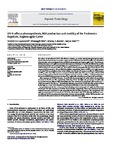UV-B affects photosynthesis, ROS production and motility of the freshwater flagellate, Euglena agilis Carter.
| dc.contributor.author | Kottuparambil, S | en |
| dc.contributor.author | Shin, W | en |
| dc.contributor.author | Brown, MT | en |
| dc.contributor.author | Han, T | en |
| dc.date.accessioned | 2015-12-10T14:11:00Z | |
| dc.date.available | 2015-12-10T14:11:00Z | |
| dc.date.issued | 2012-10-15 | en |
| dc.identifier.uri | http://hdl.handle.net/10026.1/3924 | |
| dc.description.abstract |
The effects of ultraviolet B (UV-B; 295-320 nm) radiation on certain vital physiological (photosynthesis), biochemical (production of reactive oxygen species - ROS) and behavioral (motility and orientation) characteristics were investigated in the unicellular photoautotroph, Euglena agilis Carter. The photosynthetic performance of E. agilis was recorded after exposure of between 15 and 60 min followed by a period of recovery lasting 6-24h under dim light (5-10 μmol photons m(-2) s(-1)). The maximum quantum yield of PS II (F(v)/F(m)) was reduced to 65% and 14% of initial values immediately following 15 and 30 min UV-B exposure, but recovered to 100 and 86% of the initials, respectively. Values of rETR(max) in E. agilis exposed to 15 min UV-B were similar to those of the initials, but a 30 min UV exposure resulted in 75% reduction of rETR(max) with only a 43% recovery as compared with the initial after 24h recovery. After a 60 min UV-B exposure, there were no Chl a fluorescence signals, and hence no F(v)/F(m) or rETR(max). A UV dose-dependent increase in DCFH-DA fluorescence was found in E. agilis cells, reflecting an increase in ROS production. After exposures to UV-B for between 15 and 60 min, the percentages of motile cells in the population decreased to 76, 39 and 15%, respectively. Following 24h in dim light, the percentage of motile cells increased to between 66% and 95% of the initial value. The velocity of non-irradiated cells was 60 μm s(-1), which decreased to 16-35 μm s(-1) immediately following exposure for 15-60 min. After periods of time in dim light (6, 12 and 24h) velocities had recovered to between 44 and 81% of the initial value. In untreated controls, the r-value was 0.23, indicating random movement of E. agilis, but it increased to 0.35 and 0.72 after exposure to UV-B for 30 and 60 min, respectively. There was a tendency towards vertical downward movement of cells proportional to the duration of exposure. The compactness of E. agilis decreased from 2.9 in controls to 1.8-2.3 in cells treated with UV-B although significant recovery followed. UV-B dose-dependent interaction between photosynthetic activity, ROS production and movement is discussed in terms of a UV-protective mechanism in E. agilis. | en |
| dc.format.extent | 206 - 213 | en |
| dc.language | eng | en |
| dc.language.iso | eng | en |
| dc.subject | Euglena | en |
| dc.subject | Fresh Water | en |
| dc.subject | Movement | en |
| dc.subject | Photosynthesis | en |
| dc.subject | Reactive Oxygen Species | en |
| dc.subject | Ultraviolet Rays | en |
| dc.title | UV-B affects photosynthesis, ROS production and motility of the freshwater flagellate, Euglena agilis Carter. | en |
| dc.type | Journal Article | |
| plymouth.author-url | https://www.ncbi.nlm.nih.gov/pubmed/22832280 | en |
| plymouth.volume | 122-123 | en |
| plymouth.publication-status | Published | en |
| plymouth.journal | Aquat Toxicol | en |
| dc.identifier.doi | 10.1016/j.aquatox.2012.06.002 | en |
| plymouth.organisational-group | /Plymouth | |
| plymouth.organisational-group | /Plymouth/Faculty of Science and Engineering | |
| plymouth.organisational-group | /Plymouth/REF 2021 Researchers by UoA | |
| plymouth.organisational-group | /Plymouth/REF 2021 Researchers by UoA/UoA06 Agriculture, Veterinary and Food Science | |
| plymouth.organisational-group | /Plymouth/Research Groups | |
| plymouth.organisational-group | /Plymouth/Research Groups/Marine Institute | |
| dc.publisher.place | Netherlands | en |
| dcterms.dateAccepted | 2012-06-10 | en |
| dc.identifier.eissn | 1879-1514 | en |
| dc.rights.embargoperiod | 12 months | en |
| rioxxterms.versionofrecord | 10.1016/j.aquatox.2012.06.002 | en |
| rioxxterms.licenseref.uri | http://www.rioxx.net/licenses/under-embargo-all-rights-reserved | en |
| rioxxterms.licenseref.startdate | 2012-10-15 | en |
| rioxxterms.type | Journal Article/Review | en |


